Percutane hartklep implantatie bij congenitale en ... - KCE
Percutane hartklep implantatie bij congenitale en ... - KCE
Percutane hartklep implantatie bij congenitale en ... - KCE
Create successful ePaper yourself
Turn your PDF publications into a flip-book with our unique Google optimized e-Paper software.
12 <strong>Percutane</strong>ous Heart Valves <strong>KCE</strong> Reports 95<br />
2 PERCUTANEOUS HEART VALVES<br />
2.1 PERCUTANEOUS AORTIC VALVE (PAV)<br />
The idea of the percutaneous insertion of an aortic valve resulted from the<br />
disappointing results of the percutaneous balloon aortic valvuloplasty (BAV) that was<br />
introduced in 1986, and gave rise to a high early rate of rest<strong>en</strong>osis. 24 BAV had be<strong>en</strong><br />
developed in an attempt to help pati<strong>en</strong>ts with AS, who were severely symptomatic but<br />
considered inoperable. The operability of pati<strong>en</strong>ts is based on clinical judgem<strong>en</strong>t,<br />
supplem<strong>en</strong>ted with information obtained from operative risk scores derived from<br />
historic data on pati<strong>en</strong>ts that underw<strong>en</strong>t cardiac surgery. 4 High risk indicators include<br />
advanced age, severe chronic obstructive pulmonary disease, severely reduced left<br />
v<strong>en</strong>tricular function, advanced r<strong>en</strong>al or liver failure, diabetes mellitus, and recurr<strong>en</strong>t<br />
neurologic insults.<br />
Although it reflects only a limited number of surgical risk factors, the EuroSCORE<br />
(European System for Cardiac Operative Risk Evaluation) risk score is commonly<br />
referred to in papers related to PAV insertion. It was introduced in 1999 to predict<br />
surgery related mortality risk. 25 This risk model is used for any cardiac surgery, and is<br />
not specifically designed for aortic st<strong>en</strong>osis. 13 Both a simple additive and a logistic model<br />
have be<strong>en</strong> established and validated (Figure 8.1). For a giv<strong>en</strong> pati<strong>en</strong>t, the EuroSCORE<br />
reflects the predicted operative mortality, although for pati<strong>en</strong>ts considered at the<br />
highest risk, the EuroSCORE may overestimate the surgical risk. 26, 27 This has be<strong>en</strong><br />
confirmed in a rec<strong>en</strong>tly published evaluation in a surgical series from the Mayo Clinic<br />
where an estimated 30-day mortality of 23.6% sharply contrasted with an observed<br />
mortality of 5.8%. 28 Because there is evid<strong>en</strong>ce that actual outcomes have improved, an<br />
update of the model is in preparation (“EuroSCORE 2008”) to better reflect<br />
contemporary practice. ii<br />
The concept of percutaneous insertion of a cardiac valve was first applied to the<br />
pulmonary valve, because this valve is more easily reached and tolerates less than<br />
perfect results better than the aortic valve. 12 The first human percutaneous aortic valve<br />
implant has be<strong>en</strong> performed by Cribier in April 2002. 29 Initially, PAV insertion was<br />
completed via the antegrade approach, indicating that the delivery catheter and the PAV<br />
are advanced along the direction of blood flow. After puncture of the femoral vein, the<br />
catheter is advanced to the right atrium and following puncture of the interatrial<br />
septum, the device is advanced via the left atrium through the mitral valve op<strong>en</strong>ing. In<br />
this way, positioning and deploym<strong>en</strong>t of the PAV assembly occurs across the v<strong>en</strong>tricular<br />
surface of the aortic valve which is usually less calcified, resulting in a smoother<br />
passage. 24 Because of the demanding nature of the procedure, and the pot<strong>en</strong>tial<br />
complications at the level of the mitral valve induced by the transseptal catheters, the<br />
antegrade (transv<strong>en</strong>ous) approach of the aortic valve has be<strong>en</strong> mostly replaced by the<br />
retrograde (transarterial) approach, which will be described in more detail in the next<br />
section. This technique however can be hampered due to difficulties to advance large<br />
catheters through tortuous and diffusely diseased femoral and iliac arteries, oft<strong>en</strong><br />
<strong>en</strong>countered in elderly people. These difficulties have led to the developm<strong>en</strong>t of the<br />
transapical approach where the same device is introduced from the cardiac apex via a<br />
mini-thoracotomy. Due to this selection process, pati<strong>en</strong>ts treated by the transapical<br />
route mostly have a higher risk profile than pati<strong>en</strong>ts treated by the transarterial<br />
approach. The feasibility of PAV insertion not only dep<strong>en</strong>ds on the vascular accessibility<br />
of the aorta, but is also dep<strong>en</strong>d<strong>en</strong>t on anatomic characteristics related to the asc<strong>en</strong>ding<br />
aorta and the aortic annulus. Correct sizing of the valve is critical to minimize the<br />
pot<strong>en</strong>tial for paravalvular leakage and to avoid prosthesis migration after placem<strong>en</strong>t. 7<br />
Some curr<strong>en</strong>tly accepted contra-indications for PAV are (cong<strong>en</strong>ital) bicuspid valves<br />
because of the risk of incomplete deploym<strong>en</strong>t of the prosthesis and the pres<strong>en</strong>ce of<br />
asymmetric heavy valvular calcification, which may compress the coronary arteries<br />
during PAV insertion. 7 Other contra-indications, related to a specific type of PAV will be<br />
discussed in the corresponding sections.<br />
ii http://www.euroscore.org/

















